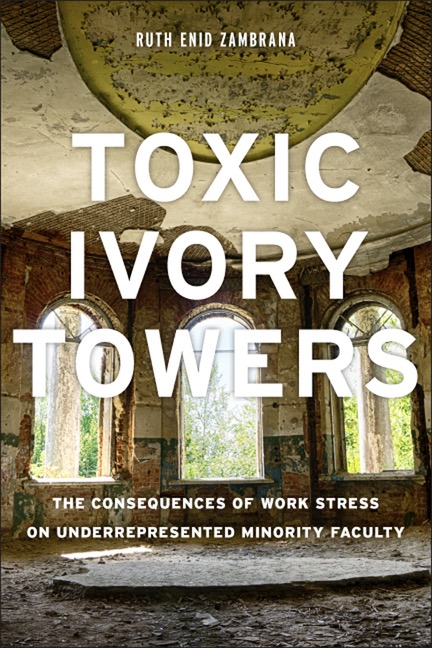stress
Select an item by clicking its checkbox
Your PowerPoint slides are not projecting on the screen as students trickle into the classroom. Normally you like to have everything prepared before their arrival, but ITS is not responding to your calls. Running on coffee and a few hours of sleep you begin the lecture only to be interrupted ...

Toxic Ivory Towers: The Consequences of Work Stress on Underrepresented Minority Faculty
Date Reviewed: April 2, 2019
Ruth Enid Zambrana’s Toxic Ivory Towers presents readers with new research on the conditions and consequences of workplace stress among underrepresented minority (URM) faculty in higher education. It draws from the “largest web-based survey of URM faculty in the United States to date” (13) and focuses particular attention on the experiences of African American, Latinx, and American Indian early- to mid-career faculty at elite universities (12). The study examines “the associations between workplace stress, academic organizational factors, coping strategies, and physical and mental health among URM faculty” (10). Zambrana also brings more than thirty-five years of experience to the table as a URM teacher, researcher, and faculty member in order to demonstrate that “workplace stress on URM faculty colleagues is uniquely and adversely impacting their lives” (21).
In chapter one, Zambrana illustrates the gap between the stated commitments and actual commitments of universities to diversity initiatives in general and to URM faculty in particular. Then chapter two explores the complicated history behind recruiting URM faculty into the academy. Chapters three through five focus on the climates in which URM faculty experience high levels of stress: climates that are often structurally racist (chapter three), that use mentoring programs to mask deeper problems (chapter four), and that foster micro- and macro-aggressive discrimination (chapter five). Chapters six through eight deal with the impact of work stress on URM homes and families (chapter six), on advancement opportunities such as promotion or tenure (chapter seven), and on emotional and professional well-being (chapter eight). Chapter nine considers the complexities around gender dynamics. Chapter ten exhorts academic leaders to listen to and learn from URM faculty experiences in order to renew their practices.
On occasion, Toxic Ivory Towers plods along on account of too many first-hand verbatim reports. More selectivity in verbatims would help with flow. Also, it would be more beneficial to readers if Zambrana proposed a clearer roadmap for the future. Creative solutions are usually more complex than learning from past mistakes and correcting them. However, the many strengths of the book will lead many readers to overlook its weaknesses. Zambrana unmasks the misleading data that a lot of universities publish on the “success” of diversity initiatives; she offers constructive language for URM faculty to help name their experiences; and, her work provokes responses that challenge the status quo. Those who read this book may experience a diverse number of responses: some may be surprised by research findings, others unsettled by testimonies, others reassured they are not alone in their experiences, and still others an aggregate of reactions. Every academic leader (presidents, deans, department chairs, and so forth) who wants positive change in these areas will benefit from interacting with Zambrana’s research, and virtually every URM faculty member will benefit from her adeptness at naming the workplace stressors that they experience.
At the time of this conversation, Eric Barreto was on the faculty at Luther Seminary, but he has since joined the faculty at Princeton Theological Seminary. His teaching practice is informed by his bi-regional and multi-lingual backgrounds. The biblical text and the ancient world are sites for destabilizing contemporary notions about the stability of historical conceptions of the possibility/ies of living harmoniously within diverse communities.
The “I” That Teaches - A new video project that invites senior scholars to talk about their teaching lives. These scholar-teachers candidly discuss how religious, educational, and family backgrounds inform their vocational commitments and, also, characterize their teaching persona. From the vantage point of a practiced teaching philosophy we get an intimate account of the value and art of teaching well.
Click here to watch all episodes of "The "I" That Teaches" on YouTube
See Also:
